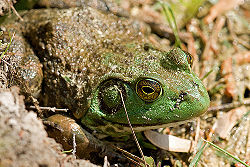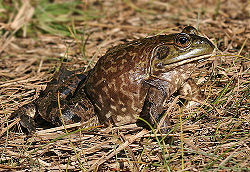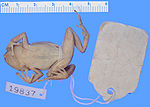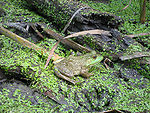Talk:Bullfrog
Original page content - parked here for possible later reinsertion... --Ashcraft - (reply) 17:49, 3 November 2017 (EDT)
| Bullfrog |
|---|

|
| Scientific Classification |
| Binomial Name |
|
Rana catesbeiana |
| A fine bullfrog showing off his powerful legs |
The Bullfrog is a very large species of North American frog known by the scientific name Rana catesbeiana. It's name is derived from it's size and its deep croak, which is call is reminiscent of the roar of a bull.[1].
Anatomy
The Rana catesbeiana is the largest bullfrog that inhabits California. The adults can be anywhere from 3.5 to 8 inches (5.7 – 11.4 cm) long, from their snout to their vent [2]. The males will grow only up to 7 1/8 inches (18 cm) [3] weighing up to 17.5 ounces[4]. While the females grow up to 8 inches (11.4 cm) [5] though they also weigh up to 17.5 ounces [6] .
Reproduction
In this species of frog the reproduction of the bullfrog happens in water, with the fertilization being external. The general mating period of the bullfrog is usually between May and late August, but can occur as early as March and as late as October. Studies in Kansas have shown that the breeding time starts for the bullfrog at around 70 degrees F (21 degrees C) [7].
Metamorphosis of tadpoles is dependent upon adequate environmental conditions (temperature, water quality, availability of food). The closer a bullfrog gets to the equator, the longer the length the reproductive period. So in places like panama and Ecuador the spawning time is just about all years, but the wild bullfrog in the United States have an average three-month reproductive season [8].
The males reach reproductive maturity in one to two years, and the females reach reproductive maturity in two to three years [9]. The females can lay up to 25 thousand eggs per Clutch [10]. After the female lays the Clutch she may loose up to twenty percent of her body weight [11]. The female will only have one litter per season [12], but the older females are capable of laying two Clutches per year [13]. After hatching, the tadpoles will receive no assistance for surviving in the world from their parents [14].
Ecology
The bullfrog is in most cases found in its natural habitat, which includes warm, sunny, open, and lasting (does not dry up next day) water. The water that they may be in is usually lakes, ponds, sloughs, reservoirs, marshes, slow rivers usually in the middle of nowhere/ isolated places, irrigation canals, and slow creeks. They can tend to get onto things such as cattle tanks. These “waters” will be found in grasslands, farmlands, prairies, woodlands, chaparrals, forests, foothills, and desert oases. [15]
People have been studying the stomach contents of the bullfrog since 1913. The studies that were done at this time and times after have told much about the bullfrog and have shown that its diet is unique to that of other North American Rana and a larger amount of the other aquatic animals [16].
The bullfrog sits and waits for its prey to come close to it and then finally when its prey is in range the bullfrog will lunge itself and its tong after its prey. It is thought that they eat other frogs after they hear the frogs sorrowful cries or its breeding calls. The bullfrog eats pretty much anything that it can overpower and stuff down its throat. This includes most invertebrates and mammals, but they mostly eat birds, fish, reptiles, and other neighboring amphibians including other bullfrogs.[17]
Hibernation
The bullfrog is found in places usually with mild temperatures, where they hibernate to outlast the cold weather [18]. It is at this time that they will find or make shallow mud to dig into to make a hole for them to hibernate in wile the weather is cold [19]. They also hibernate in places of high temperature, usually temperatures around 40 °C which would be in the summer months [20].
References
- EOL EOL, July 31, 2010,February 12, 2011, May 29, 2010, and May 27, 2009.
- California Herps California Herps, 2011.
- DFWUrbanWildlife (Webpage Down)
- Dictionary.com Dictionary.com.


